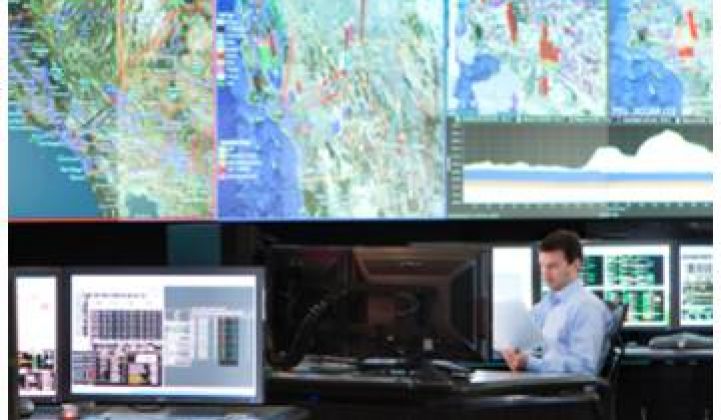DistribuTECH 2012 is here. Somewhere between the countless smart meter displays, smart thermostats and promises of interoperability, there are a few contenders that stand out.
To kick off the conference in San Antonio, TX, Bill Harmon, vice president of residential segment marketing for Reliant Energy, reminded the audience that it took nearly a half a century for electricity to reach one-quarter of the population. It took the telephone 35 years. The internet, however, took just seven years to make its way into the lives of one-quarter of Americans.
Change is coming and it may be faster than some utilities and regulators would like. Or not fast enough, depending on who you ask on the conference floor. But a few projects, voted Project of the Year in four categories by the editors of POWERGRID International, were highlighted during the keynote presentation as the best in class.
Best Energy Efficiency/Demand Response Project
Ameren Illinois and Baltimore Gas & Electric were finalists in this category, but it was Duke Energy that took home the prize with its Smart Energy Now program.
The pilot targets commercial buildings in Charlotte, N.C. and seeks to help them shed energy by providing detailed information and comparing other buildings to others in the community. The project, which is also supported by Cisco and Verizon, uses kiosks and public spaces as well as portals with more detailed information and tips for curbing energy use.
However, Cisco announced in late summer of last year it would mostly back out of building energy management. Other utilities, like Constellation Energy, are trying to squeeze more out of their demand response programs with commercial buildings by leveraging platforms from startups, like Lucid.
But Duke has the advantage of running more than just a DR program: it is part of a community campaign to put Charlotte on the map for sustainability. By 2016, the project is expecting to curb energy use by up to 20 percent. If you can capture the imagination of your customers, rather than just making a hard pitch for energy savings, it makes a difference in the success of the project.
Best Grid Integration of Renewables Project
Unsurprisingly, the winner of best renewables integration went to California, which has the nation’s most ambitious renewable portfolio standard of 33 percent. But instead of picking one of the big three utilities, the winner was the California ISO for its visual approach to managing renewables.
The visuals are provided by Space-Time Insights, a Fremont, Calif.-based startup.
On Tuesday, Greentech Media also reported that the company launched a “situational intelligence suite” of products, starting with a smart meter intelligence business application, meant to plug directly into utility deployments en masse. It’s the first in what’s intended to be a string of out-of-the-box systems to take utility asset management, smart grid and renewable power integration data and map it out on screen, in near-real time.
The California utility needed something that could integrate their legacy system with real-time data coming in from multiple sources that could be shown in one intuitive display. The offerings from Space-Time Insight, along with a new Mission Critical Wing to focus on renewables, allow the operators to make the adjustments to maximize renewables and reliability.
One Cal ISO executive said transitioning to the system “is like the difference between an x-ray and an MRI.”
Best Smart Grid Project
AEP Ohio walked away with the best overall smart grid project for its ambitious distribution automation and community-based smart technologies that are part of its gridSMART demonstration project. The pilot spans more than 100,000 customers and tackles new distribution management, volt/VAR control, advanced metering, home area networks -- and a side order of community energy storage using spent electric vehicle batteries.
The goal is to cut demand by 15 megawatts and save customers more than $5 million over the lifetime of the project. It’s an ambitious project overall, trying to understand how the utility of tomorrow might function, while also cutting an estimated 18,000 megawatt-hours of power.
Best Smart Metering Project
Best smart metering went to Toronto Hydro. However, the recognition was due as much to the dynamic pricing plans that went with Toronto’s metering deployment as it was to the fact that they’ve installed nearly 700,000 smart meters.
Ontario has been aggressive about legislating energy efficiency, making time-of-use rates mandatory. Interestingly, that mandate has not lead to significant energy savings because the broad mandate means that the spread between peak and off-peak is actually not that significant.
To deliver dynamic rates, no matter how paltry the spread, Toronto Hydro has invested in educating their customers in nearly any way they can think of, from magnets to web portals. POWERGRID gave bonus points to Toronto Hydro’s system for delivering two-way hourly data throughout a dense urban environment.
Toronto Hydro is out in front with dynamic pricing, but more because it is a regulatory mandate rather than because it has a compelling pricing scheme that customers love. On the other hand, there’s not a lot of loud complaining. The utility is also looking at developing cutting-edge solutions using the data coming from the meters, rather than just wringing their hands over the fact that so much data is coming in.



